2016 Mid-Size Truck Shootout – Toyota Tacoma, GMC Canyon, Nissan Frontier
2016 Mid-Size Truck Shootout Cont.
Suspension & Handling
Follow trails of you to here
Every mile takes you my way
Rolling faster if we can
“Born to Hula” - Queens of the Stone Age
Although these were once simply work trucks, mid-size trucks now cater to such a wide audience that good all-around handling and suspension are a must. Since we’re testing the comparable off-road 4x4 versions of each truck, they need to be competent when the pavement ends as well.
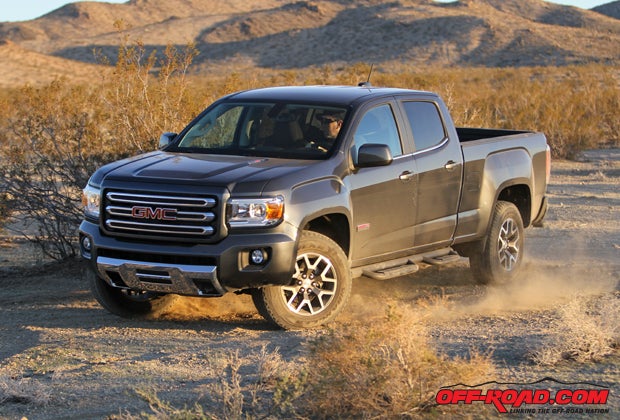
The Duramax turbodiesel adds almost 250 pounds to the Canyon’s front end, though it isn’t noticeable when rounding curves on the highway. The Canyon still delivers a light and responsive steering feel, despite being the lone long-bed option and having the longest wheelbase of our trio. The Canyon was arrow stable in a straight line and great on the highway. Hooking up to our 3300-lb. Big Tex trailer loaded with a 2015 Honda Pioneer 1000 had no noticeable effect on the Canyon’s handling or stability – in fact, some of our testers commented while towing that the Canyon feels like a bigger truck than it actually is.
Those same characteristics make for a good low-speed crawler in the off-road environment. The Canyon’s effortless and precise steering manners are much appreciated, especially when such great care has to be taken to avoid snagging the truck’s front air dam on a rock or in a ditch. The air dam on the Canyon’s front bumper is a shovel in the dirt, and although we understand its value for road fuel economy we’re disappointed that it isn’t easier to remove for off-roading or simply wasn’t installed on the All-Terrain/Z71 Off-Road package. The Canyon offers decent handling at higher speeds, but it would probably be even crisper if GM had selected a better tire profile and tread for the Canyon than the Goodyear Wranglers, because even though similar tires are found on the Tacoma (albeit the Toyota’s are mounted on 16-inch wheels instead of 17s) we felt the Canyon’s tire offered less grip, particularly on loose hills.
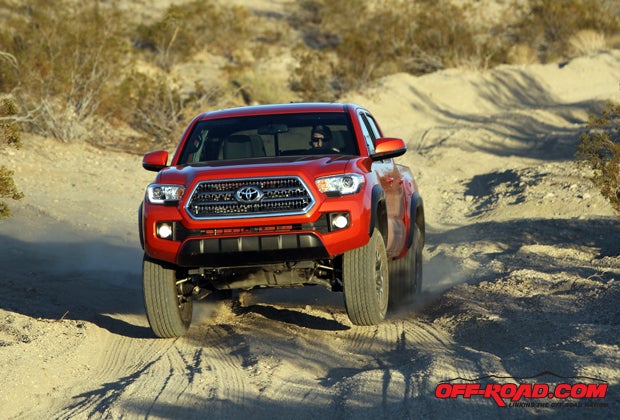
Since this isn’t the Toyota Tacoma T/X Baja option we tested last year, we knew we would have a much fairer suspension comparison in this mid-size test minus the remote-reservoir Bilsteins. Even without the next-level suspension upgrades, we still expected the Tacoma to be the suspension king of the test, and it was, but not by as large a margin as expected.
The reason for this is clear as glass: compromise. On the street, the Tacoma rides like a dream, worlds better than the boxcar-feel of the stiff and sticky T/X Baja-equipped edition we had in 2015. We found our previous-generation Tacoma test truck’s vague steering annoying last year, but that’s clearly not the case for the all-new 2016 model. The new Tacoma’s handling is leaps-and-bounds tighter and more responsive, giving the truck a downright sporty feel that trumps the Canyon.
But although the TRD Off-Road Tacoma comes with Bilstein monotube shocks like the Frontier, it appears they simply aren’t as dialed in. The Tacoma handles small road ripples and potholes with great competence, and yet when off-road it feels softly sprung and underdamped at times, causing it to bounce and buck at higher speeds. We also noticed some body roll during hard cornering. The soft suspenders don’t hinder the Tacoma’s steering through the rough stuff, but if you attack a section with any speed, be prepared for a bouncy ride. Like all three trucks in this comparison, the Toyota has a hearty, big truck-like feel in a straight line.
What saves the Tacoma’s bacon in the dirt is its best-in-class ground clearance of 9.4 inches. Knowing that you can bang your way through the deepest ruts or the largest rocks in the Tacoma is great for driver confidence when the going gets really nasty. And with its generous 32-degree approach angle, you don’t have to worry about digging in the Tacoma’s fancy new front snoot—if you just had a nose job, you wouldn’t want to smash it either.
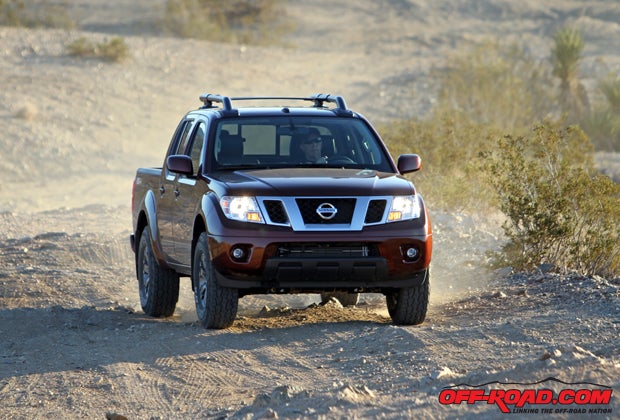
The Frontier is … well, the Frontier. Even with its speed-sensitive power rack-and-pinion steering, the Nissan’s on-road steering character is merely adequate when compared to its crisper-steering competition. What was a crisper-steering truck than the Tacoma T/X Baja we tested a year ago now finds itself solidly third in the handling category on the street because of the Toyota redesign.
Off-road is another story entirely, as the Frontier is much closer, thanks to a stiff, boxed steel chassis that minimizes flex and helps the suspension to plant the truck in undulating terrain. Steering feedback through the dirt is excellent, and the Frontier delivers the right combination of steering quickness and steering effort. Being the veteran of the bunch, the PRO-4X off-roader comes with upgraded Bilstein shocks that are nicely tuned to the truck, giving the Frontier the best rough-terrain control of the group to allow for a pretty aggressive pace in the desert. On the street you pay the price in a stiffer and jerkier ride over small pavement irregularities (which could be why Toyota’s suspension is tuned differently in the dirt). While the Frontier’s suspension is a compromise we can live with, the Tacoma still wins this category for having the best all-around suspension performance.
Towing
Boy, you gotta carry that weight
Carry that weight a long time
“Golden Slumbers - Carry That Weight - The End” – The Beatles
For our towing comparison, we loaded up our Big Tex test trailer, in this case a 50LA model, with a 2015 Honda Pioneer 1000. Our total combined weight was right at 3320 pounds, which is a fair representation for a few ATVs, small boat, small camper, etc. When it comes to the testing, the Nissan “opted out,” so to speak, since it was not equipped with a tow package in spite of its 6,100-pound max tow capacity.
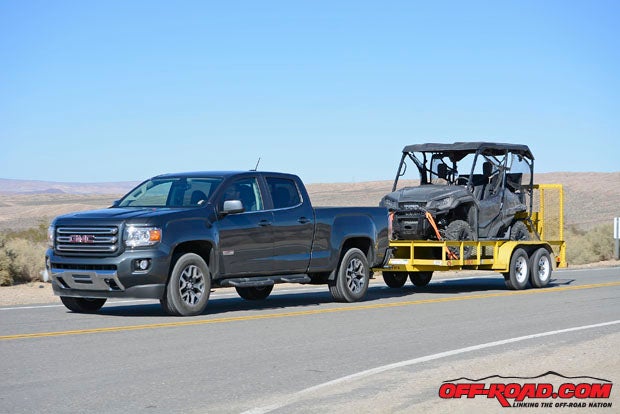
The Canyon offers the most towing capacity of our three 4x4 trucks at 7,000 lbs. on our SLE Crew Cab Long Box, and no surprise, its turbodiesel Duramax engine performed very well during testing. Actually, we’d have been floored if it didn’t performed well with its 369 lb.-ft. of torque on tap. The Canyon’s peak torque is made at 2,000 rpm, so pulling away from a stop or starting an uphill climb is no struggle for the mightly little 2.8L diesel. It climbs steep grades with no trouble, and we are impressed with how solid it feels through corners – it never feels like the trailer is tugging at the truck. The Canyon handles the weight of the trailer with supreme confidence.
The biggest plus for the Canyon in the towing department is its tow/haul mode, which also activates the exhaust brake. Even though it’s a small-displacement diesel, the exhaust brake really helps bring the Canyon to a stop, with the system aiding the four-corner disc brakes. The Canyon is also the only truck to feature a trailer brake controller.
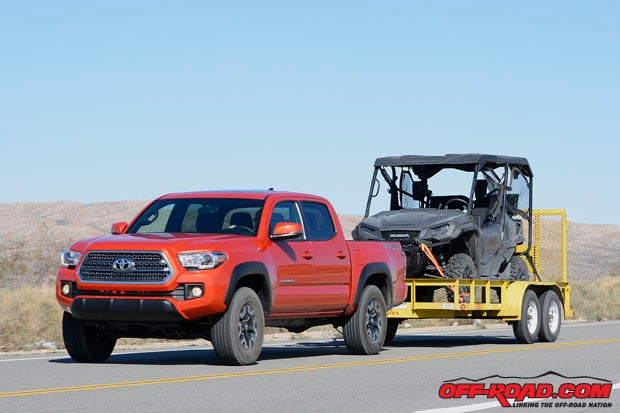
When we hitched up our 4x4 Tacoma TRD Off-Road double cab to the Big Tex trailer we greatly appreciated the rear backup camera – in fact, both the Tacoma and Canyon’s backup cameras offer a very clear picture of what’s behind the truck. They essentially make backing up to a trailer a one-man job – no spotter necessary. Our 4x4 Tacoma is rated to tow a maximum weight of 6,400 pounds, so our trailer setup tipped the scales at just over half of that max rating.
Overall, we felt the Tacoma performed well in the towing department. The naturally aspirated 3.5-liter V6 has plenty of power to get the trailer up to speed, though it clearly doesn’t have the power-to-the-ground feel of the Canyon, which is no surprise considering its torque rating is 104 lb.-ft. less. The rear end of the Tacoma did seem to feel the trailer’s weight just a little more, as there was a slight tugging feeling in the corners. Our biggest gripe with the Toyota’s towing performance came down to the transmission mapping. The Tacoma’s six-speeder downshifts far too often for our liking, and that isn’t a huge surprise since there’s no tow/haul mode to adapt the power delivery for this task.


 Your Privacy Choices
Your Privacy Choices